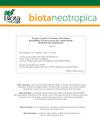Antennal sensilla in Cyclocephala literata Burmeister, 1847 (Coleoptera: Scarabaeidae: Dynastinae)
IF 1.2
4区 环境科学与生态学
Q3 BIODIVERSITY CONSERVATION
引用次数: 1
Abstract
Abstract: Adults of the beetle Cyclocephala literata Burmeister, 1847 are important pollinators to some Magnoliaceae. Is known that insects could find host plants by detecting volatiles through antennal sensilla. Cyclocephala has its three distal antennomeres lamellate, and the surface of each lamella has sensilla trichodea, chaetica, placodea, coeloconica, basiconica and ampullacea. Three kinds of sensilla placodea were found (type I, II and III), and two kinds of sensilla coeloconica were observed (type I and II). Females have on average 10,776 sensilla, of which 10,214 are sensilla placodea, 536 are sensilla coeloconica, and 26 are sensilla basiconica. Males have on average 10,386 sensilla, of which 9,873 are sensilla placodea, 464 are sensilla coeloconica, and 49 are sensilla basiconica. Males and females have similar quantities of sensilla, and sensilla placodea are predominant. The differences observed in the number of sensilla of males and females were found in other beetles and were attributed to the detection of cospecific sexual pheromones by one of the sexes, or to the detection of plant volatiles. The antennal sensilla of C. literata is described and quantified in present study, and some perspectives about the differences kind of chemical communication, pollination, and antennae dimorphism is discussed.摘要/ Abstract摘要:Cyclocephala literata Burmeister, 1847是一些木兰科植物的重要传粉者。众所周知,昆虫可以通过触角感受器检测挥发物来寻找寄主植物。环头的三个远端触角呈片状,每个薄片的表面有毛感器、毛感器、盘感器、腔感器、基感器和壶壶。雌性平均有10776个感受器,其中placodea感受器10214个,coeloconica感受器536个,basiconica感受器26个。雄性平均有10386个感受器,其中placodea感器9873个,coeloconica感器464个,basiconica感器49个。雄性和雌性有相似数量的感受器,以placodea感受器为主。在其他甲虫中也发现了雄性和雌性感受器数量的差异,这可能是由于一种性别对共特异性性信息素的检测,或者是对植物挥发物的检测。本文对黄杨的触角感受器进行了描述和定量化,并对其在化学通讯、传粉和触角二态性方面的差异进行了讨论。
本文章由计算机程序翻译,如有差异,请以英文原文为准。
求助全文
约1分钟内获得全文
求助全文
来源期刊

Biota Neotropica
BIODIVERSITY CONSERVATION-
CiteScore
2.90
自引率
16.70%
发文量
0
审稿时长
4-8 weeks
期刊介绍:
BIOTA NEOTROPICA is an electronic, peer-reviewed journal edited by the Program BIOTA/FAPESP: The Virtual Institute of Biodiversity. This journal"s aim is to disseminate the results of original research work, associated or not to the program, concerned with characterization, conservation and sustainable use of biodiversity within the Neotropical region.
Manuscripts are considered on the understanding that their content has not appeared, or will not be submitted, elsewhere in substantially the same form, because once published their copyrights are transferred to BIOTA NEOTROPICA as established in the Copyright Transfer Agreement signed by the author(s).
 求助内容:
求助内容: 应助结果提醒方式:
应助结果提醒方式:


